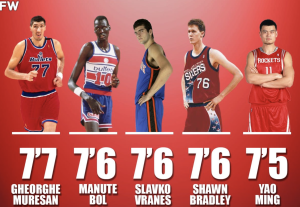2
Section One: The Fundamentals
A) History and Context
Exercise 1: Notebook Prompt
|
I am certainly not as well versed in the history of sports as I likely should be, but I would have never believed that “nude parades” existed. The idea that men would walk around judging women’s bodies just to ensure that they are in fact women seems ludicrous. This also places into my mind the question of how many times did this practices get way out of hand? The integration of women into sport seems to have incorporated practices put into place with I assume a false premise of being what is in protection of women. Barnes goes on to write about several women who are judged for not being “women enough” or for having bodies that produced too much testosterone. These athletes being judged for something that they are biologically unable to change and then instead of altering the rules to incorporate an wholistic version of gender they are forced to take medications that alter hormone levels. This also brings to question what long term side effects do they endure by taking this medication in order to compete? |
B) Timeline of History
Exercise 2: Notebook Prompt
What other significant case/milestone would you add to this timeline? Note it in your notebook along with a brief (one or two sentences) explanation of why you feel it is important.
| I think that Dutee Chand’s 2015 court ruling should also be included within the milestones. This suspension of the world athletics policy created a difference between endogenous testosterone levels and anabolic steroids. While in the end this did end up being turned over again, and also lead to having to suppress testosterone levels, it did also start the research and further questions into the topic. The fact that Chand fought for the fact that she should not be penalized for the body she was born with is an important milestone. |
C) Gender coding in Sports
Exercise 3: Notebook Prompt
Has the gendering of sport ever been a constraint on your involvement? How?
Or, if not, why do you think this is?
|
Gendering of sport has never been a constraint on my involvement. I think that this is perhaps because I have not been as intrenched in sport as some people. I have participated and been encouraged into sports throughout my life that are seen as more male dominated such as rugby and hockey, and while the crowds looked very different between our games versus the boys it was never something that I took note in. I think this is because I grew up as that being the normal and never knew people who choose to fight that misconception, nor did I do that myself. I can see how others who were more successful in athleticism than I could have felt that constraint. |
D) How is sport gendered in the popular imagination?
Exercise 4: Padlet/Notebook Prompt
While most sports are in fact unisex, gender coding remains pervasive, particularly at the professional level, although with a foundation established in youth competition. Participate in the poll below to share your views on how popular sports are gendered in the popular imagination. Also feel welcome to add or suggest sports that you feel strongly conform to the gender binary!
After you contribute to the padlet prompt, record your response in your notebook AND briefly discuss in two or three sentences how these responses and the polling figures in general confirm or contradict your assumptions about gender-coding and sports. Did anything surprise you?
|
The responses within the padlet seem confirm a common assumption about gender coding and sports. The polls in all but one or two seem to be quite similar in ratings. The sports that are more widely televised or publically promoted regardless of who can play them are seen as male dominated and those that play into feminine roles such as cheerleading or gymnastics are voted as female. It was interesting to see that neutral sports only truly dominated within surfing, tennis, and swimming. |
Section Two: Breaking it down
A) Title IX
Exercise 5: Notebook Prompt
In a longer version of the interview excerpted in the video above, Leah Thomas states “Trans women competing in women’s sports does not threaten women’s sports as a whole because trans women are a very small minority of all athletes and the NCAA rules around trans women competing in women’s sports have been around for 10+ years and we haven’t seen any massive wave of trans women dominating”?
Do you agree with this statement? See also the image above suggesting that the issue may be overblown by politicians and influencers who don’t actually care that much about women’s sports.
Please share any thoughts you have in your Notebook by clicking on the audio button above or writing a few sentences.
| Within the confines of the statement above I would have to agree. There currently does not seem to be a large threat or a dramatic increase in trans women dominating within sport. There are always a varying conversation in this way where politicians and people can exploit trans people, because within the media it holds this power of anger. The strange ability to anger so many people not only creates more attention but keeps it within the headlines for a lot longer. The truth here however is that there is a very small minority and within that population they do not monopolize the top percentage as the statement above holds. |
B) Unfair Advantage?
Exercise 6: Notebook Prompt
What does the host and writer, Rose Eveleth, have to say on the issue of unfair advantage?
Can you think of other examples of unique biological or circumstantial advantages from which athletes have benefitted enormously that have nothing to do with gender?
 . .
The issue of fairness or the unfair advantage is much more complex than it is proposed to be. The issue of gender or being trans gender is in reality only a very small part of that. Rose Eveleth speaks about the vast amount of advantages that people can hold some that are quite visible like height or weight and others bellow the surface such as increased ability to make red blood cells. The difference that Rose is trying to highlight is that in many of these other contexts these athletes are praised for their advantage. The comparison of athletes such as Eero Mäntyranta and Caster Semenya where both have a genetic alteration one in creating more Erythropoietin and the other in testosterone. One athlete is a marvel to the sport the other is forced to chemically alter the makeup of her body. There are many other examples such as Gheorghe Muresan and Manute Bol who are over 7 foot tall making them excellent competitors in basketball. The horse jockeys who excel only when they have a tiny frame and tom Sietas who can hold his breath for 22 minutes due to having lungs 20% larger than the average man.
|
Again, let’s turn to Katie Barnes who points out that we tend to forget amidst all the debate that “sports, by design, are not fair” (235), that “the reality of sports is that we accept unfairness all the time” (235).
Do you agree? Why? In your experience, how fair are sports? Feel welcome to add a video response in the padlet and provide an example if you’re willing. Make sure you include a screenshot of your response in your notebook.
|
I have to agree that sports are not completely fair. I would in fact also argue that there isn’t anything in life that is completely fair either. The saying “life isn’t fair” is there for a reason. There are several factors that effect fairness in terms of sport including financial and access to resources, biological, and social. We have already looked at various biological advantages and how they can help some athletes to excel in their specific sport. The access to resources can also push athletes into higher categories, more time spent within a sport especially at a younger age can certainly make a dramatic difference. The last thing that I got thinking about is a social aspect. In this way I think of for example that the small town mentality can have an impact. I can see the push for children to play hockey especially in the communities that I have lived within. This mentality that, well they must learn to skate, and certainly they can play other sports but hockey must be one of them. This can lead to internal turmoil for the child and the parents and limit time spent on something that they are more passionate about and excel at. I can also see how many people have written about the fact that sports tend to rely on a third party in terms of a ref or judges. There is also a degree of unfairness as it is difficult for humans to make choices without any emotion at all. There is also a degree of error that humans have in general leading to things such as missed calls ect. |
B) The Paris Olympics
What does Robins mean when she argues that:
“The aims of transvestigating an Olympic athlete are not, in any meaningful sense, anything to do with sports, or fairness, or even with women (cis women, at least) as a social category. Rather, they have everything to do with transness, and the public expression of transfemininity.
For my money this has never been about sport.
What it has always been is an excuse to publicly relitigate the existence of trans women.”
Make a note in your Notebook.
|
Robins speaks about how people have taken a stance that aligns with their views on trans people that has nothing to do with sport or anything else. This view is then portrayed in a way to make it seem as though they fight for women’s right in sports to avoid seeming as though they are not out and right accosting people for being trans in and of itself. They have instead in someways found a scapegoat to be able to voice their negative views with a righteous platform. I think that Robins is also trying to bring to light how little people think or research for themselves and how easily it is to take a hateful stance on something they know nothing about.
|




